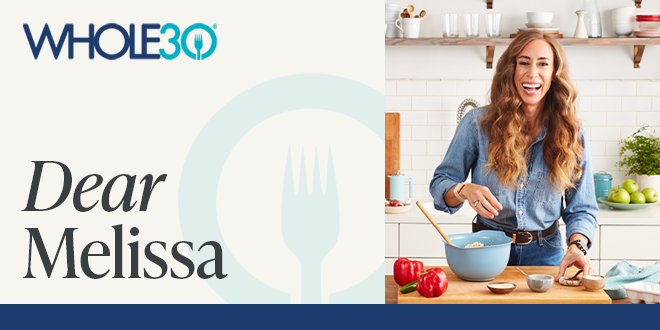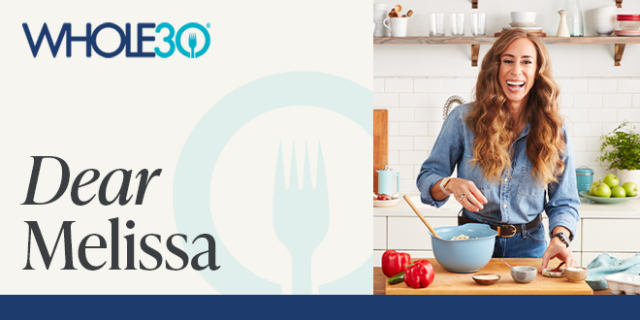If you’ve been following me on Instagram, you KNOW I’m a huge fan of the B.A.S. (otherwise known as the Big A** Salad). I eat them out of huge serving bowls or glass storage containers, as these salads are packed with ingredients. They’re the furthest thing from a boring, limp, and lifeless salad; these are hearty, satisfying, protein-rich meals.
But there’s a trick to building a B.A.S., layering flavors, textures, and even temperatures to ensure each bite is a flavor delight. After many years of trial and error, I’ve perfected the process, so I thought I’d share my template with you today from the bottom up. (Note, everything listed here is Whole30 compatible for the Original or Plant-Based programs, but feel free to add your own favorite food freedom ingredients.)
The base
Salad greens, obvi, but not just any salad greens. You need a sturdy green to stand up to the kind of ingredients we’re about pile on our salads. Butter or Bibb lettuce just won’t do, as it wilts so fast. While baby spinach is nutrient-packed, it also tends to get soggy in this context. Your best bet is to use a base of heartier greens like Romaine, massaged kale (this will make you love kale salads), or shredded cabbage, then add in some arugula, Swiss chard, or escarole for flavor contrast. You can even bake your salad greens! Sturdier bases like cabbage or kale can be warmed in the oven for even more fall appeal.
Protein (warm satiety)
This is my secret weapon for the most satisfying salads year-round… always add warm protein. Your mouth will love the contrast between the warm chicken, salmon, shrimp, steak, or tofu against the crisp, cool flavors of the greens and fixings. I cook a pound of protein all at once, either roasting, air-frying, or pan-frying. Then, I portion it out into my salads throughout the week. And yes, I reheat my protein before adding to to my salad! According to Traditional Chinese Medicine, cold meals eaten in cold seasons can be hard on your energy and digestion. Warming your protein and heartier veggies provides balance against the cold, windy, damp fall and winter seasons.
Veggies (warm heartiness)
I like adding warm roasted veggies to my salads for texture, contrast, and heartiness. Roasted sweet potato, Yukon gold potato, butternut squash, cauliflower, or broccoli are favorites, especially if you cook them until they’re browned, so they impart a hint of sweetness. You can large-dice or slice in thicker rounds—sometimes I even add giant chunks of roasted sweet potato to my salad, so each one requires several bites to finish. You can also use beets (warm or cold work here).
Veggies (cold crunch)
Crunch-worthy veggies add texture and nutrition to my salads. Try red or green pepper, celery, shredded carrot, jicama, cucumber, radishes, marinated red onion, or even grape tomatoes for a lovely “pop” inside your mouth.
Fruit (sweetness)
I love salads with pops of sweetness from fruit. My favorites are diced apple, pear, dried cranberries (sweetened with apple juice), or dried cherries year-round. In summer, I’ll add mango, grapes, strawberries, or blueberries. In fall and winter, I love mandarin orange segments, diced apples, or pomegranate. Any fruit will do, but I go easy on the dried fruit as a little goes a long way. I’ll also add avocado here! (Technically, it is a fruit, although it’s not sweet.) But chunks of avocado can provide creaminess, satiety, and flavor to any salad.
Herbs (flavor)
Another salad secret weapon is cutting fresh herbs into the salad just before serving. Basil, parsley, cilantro, dill, tarragon, or chives will go a surprisingly long way to wake up your taste buds. You can also zest lemon, lime, grapefruit, or orange over the top for a huge pop of bright, crisp acidity.
Toppings (crunch)
Next, sprinkle some crunch on top, adding yet another layer of texture. The easiest way to do this is with nuts and seeds—chopped almonds, walnuts, hazelnuts, pecans, or cashews are a favorite. (Bonus—toast them lightly on the stovetop first.) You can also use sunflower seeds, no chopping necessary. Other ingredients can also provide a crunchy topping, like pomegranate seeds, crispy shallots, crisp crumbled bacon, or pan-fried sage.
Dressing (smoothness and flavor)
The final step is drizzling or tossing your salad in your dressing of choice. One thing I like about my salad template is that there is so much stuff in it, dressing feels like a bonus enhancer, not the star of the show. Pair your dressing of choice, whether vinaigrette or creamy, with your salad ingredients, and err on the side of dressing too light rather than overdressing. You want the flavors from your ingredients to shine through, so use the dressing as a finishing touch. You can also use unconventional ingredients as a “dressing,” like salsa, pico de gallo, or a drizzle of hot sauce.
You’re gonna need a bigger bowl
So there you have it—my recipe for the perfect B.A.S. It will likely take some experimenting to find the flavor combinations you like the best, but isn’t that good news? It means you have lots of hearty, delicious, novel meals on your horizon! Write down the combos you love the best, so you can easily recreate your favorites in the future.
Happy salad building—and trust me on that bigger bowl suggestion.














